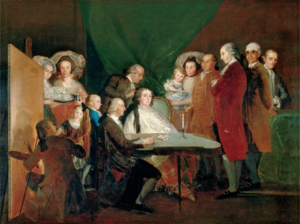Spanish Romanticism artist Francisco Goya (1746 – 1828) is famous for many reasons. For starters, he is regarded as one of the most influential painters. His anti-war paintings changed the way people saw war, and his “Black” paintings collection contributed to the growth of the field now known as modern psychology.
Despite all these claims, Goya’s position as the court painter for the Royal family of Spain earned him bread and butter. Goya spent over twenty years in the role that saw four different monarchs on the throne.
However, all indications indicate that Goya may not have enjoyed this job very much. Critics have noted how Goya’s anti-war solid stance, society’s general opinion, and how many of the royal portraits themselves seem almost satirical are proof of Goya’s distaste for high society, corruption, and ignorance.
Ferdinand VII at the Encampment (1815)
This was one of the last royal works of artist Francisco Goya. It depicts Ferdinand VII in full military dress at an encampment somewhere in Spain. Unfortunately, despite the detail of the horses in the background, the portrait of Ferdinand VII himself is far less flattering and detailed compared to previous portraits.
This can be seen as a result of Goya’s growing dislike of the oppressive ruling over the Spanish people by the crown. This regime was responsible for the death and exile of many of Goya’s friends. It would eventually even contribute to Goya’s last exile.
Critics have noticed how Ferdinand VII looks no different or no better than any other army General in this portrait. There is no Romance or glorification presented here. This painting itself can be seen as representing Goya’s change from Romanticism to Realism. A sign of darker paintings to come.
The Family of the Infante Don Luis (1784)

Goya was first introduced to the Royal family by King Charles III’s half-brother, Luis Antonio, the Cardinal-Infante. Goya spent two years painting portraits of the Cardinal and his family, which eventually led to Goya obtaining a painting position in the court of King Charles III.
“The Family of the Infante Don Luis” is the most prestigious painting Goya painted during the time with the King’s brother. It portrays Don Luis in his estate, with his wife, children, and some of their extended family. It differs from other portraits in that it has a more relaxed atmosphere.
The family is happy and smiling, and nobody seems to be posing or putting up a front, so common in portraits. It would be one of the portraits that first interested King Charles III in Goya’s work and would serve as inspiration for Goya’s later portrait of King Charles IV and his family.
King Charles III in Hunting Dress (1786)
King Charles III would be the first monarch Francisco Goya would paint a portrait for. He had painted many portraits of important figures by this point, but never a King. This would start a relationship that saw Goya paint three generations of the one family as each ascended to the King’s throne.
Goya was becoming known for his more relaxed approach to portrait painting and continued this method when it came to commissioning the King’s portrait. Goya chose to portray the King in his hunting attire instead of his royal dress.
Whether this was Goya’s choice cannot be said for sure, but it lends to the idea that Goya wanted the elderly King to be more relaxed and at ease during the process. This shows in the painting, as the King can be seen smiling with his hunting rifle in his hand and his trusty hound by his side.
King Charles IV and His Family (1801)
After the death of King Charles III, his son Charles IV took up the throne. During this time, Goya was officially appointed the first painter of the crown court and would go on to paint dozens of portraits for the members of the royal family.
The most famous portrait that he produced during this time and arguably one of his most famous paintings was that of “King Charles IV and His Family.” The painting consists of the Royal family assembled in their finest outfits and even includes Goya himself.
Many critics also see this painting as the prime example of Goya’s dissatisfaction with the crown. They believe that the painting consists of a satirical undertone, with the seemingly comical faces of the family and the Queen being in the center of the painting instead of the King. However, this is unproven and is merely an interpretation.
Ferdinand VII in Court Dress (1814)
Prince Ferdinand VII would find his way onto the throne under unique circumstances. Following an uprising against King Charles IV, which resulted in the monarch’s fall, Ferdinand VII, the King’s son, led the rebellion and ascended to the throne.
However, Napoleon would capture the Spanish crown for himself and put his brother on the throne less than one year later. This was a particularly troubling time for Goya. He was one of the most prominent anti-war advocates and would have seen many people he knew die.
Despite this, he remained the Court painter. However, he never painted a portrait of the French King and claimed loyalty to Spain. Eventually, Ferdinand VII would reclaim the throne. The 1814 portrait is of a King who has just taken back his crown. With royal scepter in hand and crown jewels around his neck, he stands proud, yet, with a distrustful look still in his eyes.
The Bottom Line
When you think about the works of artist Francisco Goya, a few things come to mind. First, both his cultural and historical impact are undeniable. His paintings of the Royal family are just one aspect of his contributions to art.














